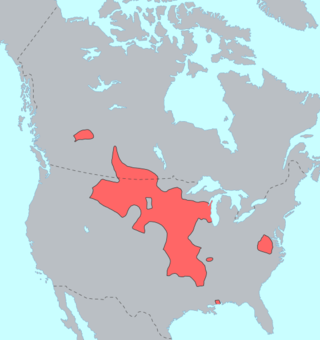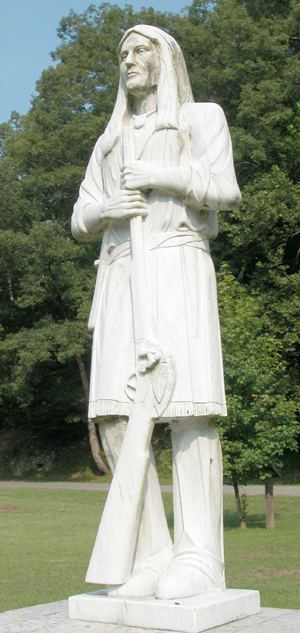Related Research Articles
Mobilian Jargon was a pidgin used as a lingua franca among Native American groups living along the Gulf of Mexico around the time of European settlement of the region. It was the main language among Indian tribes in this area, mainly Louisiana. There is evidence indicating its existence as early as the late 17th to early 18th century. The Indian groups that are said to have used it were the Alabama, Apalachee, Biloxi, Chacato, Pakana, Pascagoula, Taensa, Tunica, Caddo, Chickasaw, Houma, Choctaw, Chitimacha, Natchez, and Ofo. The name is thought to refer to the Mobile Indians of the central Gulf Coast, but did not originate from this group; Mobilian Jargon is linguistically and grammatically different from the language traditionally spoken by the Mobile Indians.

The Western Siouan languages, also called Siouan proper or simply Siouan, are a large language family native to North America. They are closely related to the Catawban languages, sometimes called Eastern Siouan, and together with them constitute the Siouan (Siouan–Catawban) language family.

Fort Ancient is a name for a Native American culture that flourished from c. 1000–1750 CE and predominantly inhabited land near the Ohio River valley in the areas of modern-day southern Ohio, northern Kentucky, southeastern Indiana and western West Virginia. Although a contemporary of the Mississippian culture, they are often considered a "sister culture" and distinguished from the Mississippian culture. While far from agreed upon, there is evidence to suggest that the Fort Ancient Culture were not the direct descendants of the Hopewellian Culture. It is suspected that the Fort Ancient Culture introduced maize agriculture to Ohio. The Fort Ancient Culture were most likely the builders of the Great Serpent Mound. Recent archeological study and carbon dating suggests that Alligator Mound in Granville also dates to the Fort Ancient era, rather than the assumed Hopewell era. It is believed that neither the Serpent or Alligator Mounds are burial locations, but rather served as ceremonial effigy sites.

The Tunica-Biloxi Indian Tribe, formerly known as the Tunica-Biloxi Indian Tribe of Louisiana, is a federally recognized tribe of primarily Tunica and Biloxi people, located in east central Louisiana. Descendants of Ofo (Siouan-speakers), Avoyel, and Choctaw (Muskogean) are also enrolled in the tribe.

The Quapaw people are a tribe of Native Americans that coalesced in what is known as the Midwest and Ohio Valley of the present-day United States. The Dhegiha Siouan-speaking tribe historically migrated from the Ohio Valley area to the west side of the Mississippi River in what is now the state of Arkansas; their name for themselves refers to this migration and to traveling downriver.

Siouan or Siouan–Catawban is a language family of North America that is located primarily in the Great Plains, Ohio and Mississippi valleys and southeastern North America with a few other languages in the east.
Biloxi, Mississippi is a city in southeastern Mississippi, United States.
The Mosopelea, or Ofo, were a Siouan-speaking Native American people who historically lived near the upper Ohio River. In reaction to Iroquois Confederacy invasions to take control of hunting grounds in the late 17th century, they moved south to the lower Mississippi River. They finally settled in central Louisiana, where they assimilated with the Tunica and the Siouan-speaking Biloxi. They spoke the Ofo language, generally classified as a Siouan language.

The Saponi is a Native American tribe historically based in the Piedmont of North Carolina and Virginia. They spoke a Siouan language, related to the languages of the Tutelo, Biloxi, and Ofo.

The Manahoac, also recorded as Mahock, were a small group of Siouan-language Native Americans in northern Virginia at the time of European contact. They numbered approximately 1,000 and lived primarily along the Rappahannock River west of modern Fredericksburg and the Fall Line, and east of the Blue Ridge Mountains. They united with the Monacan, the Occaneechi, the Saponi and the Tutelo. They disappeared from the historical record after 1728.

The Biloxi tribe are Native Americans of the Siouan language family. They call themselves by the autonym Tanêks(a) in Siouan Biloxi language. When first encountered by Europeans in 1699, the Biloxi inhabited an area near the coast of the Gulf of Mexico near what is now the city of Biloxi, Mississippi. They were eventually forced west into Louisiana and eastern Texas. The Biloxi language--Tanêksąyaa ade--has been extinct since the 1930s, when the last known native semi-speaker, Emma Jackson, died.

The Tutelo were Native American people living above the Fall Line in present-day Virginia and West Virginia. They spoke a Siouan dialect of the Tutelo language thought to be similar to that of their neighbors, the Monacan and Manahoac nations.

The Cheraw people, also known as the Saraw or Saura, were a Siouan-speaking tribe of Indigenous people of the Southeastern Woodlands, in the Piedmont area of North Carolina near the Sauratown Mountains, east of Pilot Mountain and north of the Yadkin River. They lived in villages near the Catawba River. Their first European and African contact was with the Hernando De Soto Expedition in 1540. The early explorer John Lawson included them in the larger eastern-Siouan confederacy, which he called "the Esaw Nation."

James Owen Dorsey was an American ethnologist, linguist, and Episcopalian missionary in the Dakota Territory, who contributed to the description of the Ponca, Omaha, and other southern Siouan languages. He worked for the Bureau of American Ethnology of the Smithsonian Institution from 1880 to 1895, when he died young of typhoid fever. He became known as the expert on languages and culture of southern Siouan peoples, although he also studied tribes of the Southwest and Northwest.
The Occaneechi are Native Americans who lived in the 17th century primarily on the large, 4-mile (6.4 km) long Occoneechee Island and east of the confluence of the Dan and Roanoke rivers, near current-day Clarksville, Virginia. They spoke one of the Siouan languages, and thus related to the Saponi, Tutelo, Eno and other Southeastern Siouan-language peoples living in the Piedmont region of present-day North Carolina and Virginia.

The Moneton were a historical Native American tribe from West Virginia. In the late seventeenth century they lived in the Kanawha Valley, near the Kanawha and New Rivers.

The Ofo language was a language spoken by the Ofo people, also called the Mosopelea, in what is now Ohio, along the Ohio River, until about 1673. The tribe moved south along the Mississippi River to Mississippi, near the Natchez people, and then to Louisiana, settling near the Tunica.

The Mingo people are an Iroquoian group of Native Americans, primarily Seneca and Cayuga, who migrated west from New York to the Ohio Country in the mid-18th century, and their descendants. Some Susquehannock survivors also joined them, and assimilated. Anglo-Americans called these migrants mingos, a corruption of mingwe, an Eastern Algonquian name for Iroquoian-language groups in general. The Mingo have also been called "Ohio Iroquois" and "Ohio Seneca".

The Tunica people are a group of linguistically and culturally related Native American tribes in the Mississippi River Valley, which include the Tunica ; the Yazoo; the Koroa ; and possibly the Tioux. They first encountered Europeans in 1541 – members of the Hernando de Soto expedition.

The protohistoric period of the state of West Virginia in the United States began in the mid-sixteenth century with the arrival of European trade goods. Explorers and colonists brought these goods to the eastern and southern coasts of North America and were brought inland by native trade routes. This was a period characterized by increased intertribal strife, rapid population decline, the abandonment of traditional life styles, and the extinction and migrations of many Native American groups.